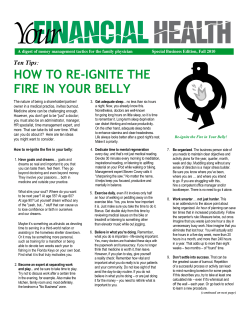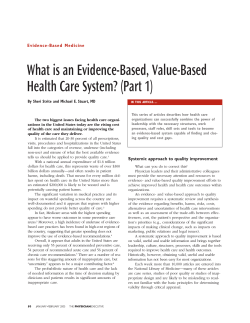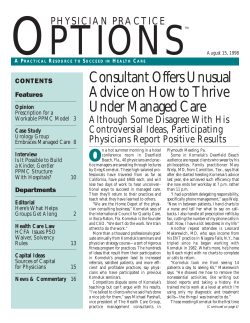
How to Find Answers to Clinical Questions
special article How to Find Answers to Clinical Questions Mark H. Ebell, MD, MS, University of Georgia, Athens, Georgia Many barriers exist to finding answers to physicians’ clinical questions. Lack of time, resources, and computer skills, as well as physicians’ environment and attitudes about problem solving, all contribute to unanswered questions. Making use of computer-based information resources can give physicians a framework for answering questions and keeping their practice consistent with the best available evidence. (Am Fam Physician. 2009;79(4):293-296. Copyright © 2009 American Academy of Family Physicians.) This is the second article in a six-part series about finding evidence and putting it into practice. A dmit it. You have questions about patient care that you never take the time to look up. When asked at the end of the day, most physicians can recall one or two questions about patient care that went unanswered.1 But when asked after every patient visit, it turns Table 1. Possible Solutions to Barriers to Answering Clinical Questions Barrier Possible solutions Attitude Value your own questions and write them down as they occur Respond positively when colleagues ask questions Create a “question-and-answer club” where you and your colleagues share the best available evidence to answer recent clinical questions Environment Make computers available where you practice, or carry a tablet computer, PDA, or smartphone Plan adequate time every week or month to review recent literature Lack of computer skills Attend computer boot camps at AAFP national meetings Buy a PDA or smartphone and practice using it Take classes at a local college or read books that teach basic computer skills Practice searching for answers to become more proficient Lack of resources Subscribe to relevant evidence-based information sources Create a Web portal that has links to commonly used information sources (see http://www.google.com/ig or http://www.myhq.com) Keep a computer, PDA, or smartphone handy while seeing patients or while on rounds Lack of time Carry a PDA or smartphone for rapid access to information Make sure computers are available wherever you see patients AAFP = American Academy of Family Physicians; PDA = personal digital assistant. Information from references 1 and 2. out that we have 15 to 20 questions per day, most of which went unanswered.1 Whether it is a new language, a new physical skill, or a clinical question, adults learn to solve problems. For physicians, those problems are the questions that arise during the care of our patients. Why don’t we answer all of our questions? There are many barriers, one of which is lack of time.2 Finding an answer can take time, especially if we have to leave the room or aren’t skilled at using computers. And you do have to use computers, because medical knowledge is changing more and more rapidly. In fact, the average textbook on a family physician’s bookshelf is more than 10 years old.3 Just think how many new drugs, tests, and guidelines have become part of routine practice during that time. Other barriers include lack of skill in searching for information, lack of access to relevant references, and thinking that the answer isn’t available (Table 1).1,2 Some barriers are cultural—if you work in a group where the emphasis is on productivity and not making waves, questions may be discouraged. Figure 1 traces the process of asking and answering questions, including common barriers.1 Think about which barriers exist in your practice and what you might do to address them. In addition to a way to answer questions at the point of care, you also need a way to stay current with new studies. Even if you don’t need information from a new study today, you should be alerted to it so you know it is available when you need it. And of course, you need to be able to quickly answer questions between patients. Your information sources should give you access to all types of information. Downloaded from the American Family Physician Web site at www.aafp.org/afp. Copyright © 2009 American Academy of Family Physicians. For the private, noncommercial use of one individual user of the Web site. All other rights reserved. Contact copyrights@aafp.org for copyright questions and/or permission requests. 1 Unrecognized information need New medical knowledge 5 Implemented information need Attitude (reflective versus nonreflective; single-loop versus double-loop learner) 2 Recognized information need Environment Importance of question 4 Satisfied information need Knowledge of resources Skill (framing questions, searching, understanding answers) 3 Pursued information need Environment Attitude (compulsive versus noncompulsive) Importance of question Knowledge of resources Environment Figure 1. The process of asking and answering clinical questions and relevant barriers. Reprinted with permission from Ebell M. Information at the point of care: answering clinical questions. J Am Board Fam Pract. 1999;12(3):229. The most useful information is relevant, valid, and takes little work to access and apply.4 Increasingly, that information is computer-based. Books are out of date the moment they hit the bookshelves, because there is at least a six-month delay between editing and publication. Although some computer-based information sources are also static, many are updated almost continuously—an increasingly important advantage. Computers also make it easy to take advantage of the increasing number of validated decision-support tools. For example, Figure 2. A clinical decision rule for a handheld computer. Information from reference 5. 294 American Family Physician www.aafp.org/afp Volume 79, Number 4 ◆ February 15, 2009 Answering Clinical Questions Table 2. Selected Evidence-Based Sources of Medical Information Source Comment Web site ACP Physicians’ Information and Education Resource Subscription-based online textbook from ACP; PDA version available http://pier.acponline.org Agency for Healthcare Research and Quality Includes USPSTF and EPC reports; PDA and smartphone application is available for screening and prevention recommendations USPSTF: http://www.ahrq.gov/clinic/ prevenix.htm Bandolier British online periodical that reviews evidence for important clinical questions http://www.medicine.ox.ac.uk/bandolier Clinical Evidence Handbook Subscription-based online reference; freely available for physicians who receive the print summary from United Healthcare; PDA and smartphone version available. Excerpted monthly in AFP http://clinicalevidence.bmj.com Cochrane Collaboration Extensive database of systematic reviews and clinical trials. Excerpted monthly in AFP http://www.cochrane.org DynaMed Subscription-based online textbook http://dynamicmedical.com Essential Evidence Plus (formerly InfoRetriever) Subscription-based online reference with extensive calculators, decision support tools, POEMs, and Cochrane systematic reviews; PDA and smartphone version available http://www.essentialevidenceplus.com Institute for Clinical Systems Improvement Nonprofit consortium of physicians and insurance companies that writes and disseminates evidencebased practice guidelines http://www.icsi.org/guidelines_and_more/ National Guideline Clearinghouse Includes evidence-based and consensus guidelines; limit to former by using “detailed search” option and limiting results to guidelines that weight evidence according to a rating scheme http://www.guidelines.gov Turning Research Into Practice Database Searches multiple evidence-based Web sites simultaneously http://www.tripdatabase.com EPC: http://www.ahrq.gov/clinic/epcix.htm ACP = American College of Physicians; AFP = American Family Physician; EPC = Evidence-based Practice Center; PDA = personal digital assistant; POEM = patient-oriented evidence that matters; USPSTF = U.S. Preventive Services Task Force. it would be difficult to remember the Wells rule for diagnosis of pulmonary embolism, which consists of eight findings from the patient’s history and physical examination plus a fairly involved decision algorithm.5 However, it is easy to use this rule when it is converted to an interactive calculator on a handheld computer (Figure 2).5 Which information sources can you trust? What makes a medical reference, electronic or otherwise, evidence-based? Perhaps the single best indicator is whether the reference clearly states how strong the evidence is to support recommendations about patient care. In American Family Physician, we use the Strength of Recommendation Taxonomy (SORT) system (http://www.aafp.org/ online /en/home /publications /journals / afp/afpsort.html). If a medical reference doesn’t tell you the strength of evidence behind key recommendations, it is difficult to know whether there is evidence of benefit for our patients. February 15, 2009 ◆ Volume 79, Number 4 Another good sign of evidence-based material is when the reference carefully describes how the literature was searched, so you can be confident they looked at all of the evidence rather than just a selection of it. Finally, you should know if a company or special interest group with a vested interest in the topic sponsored the study. Articles may be biased because the sponsor provided a biased literature search, because the authors are unknowingly biased in favor of the sponsor because of the grant or fee for writing the article, or because in some cases the article is largely written for them by a medical communications company (i.e., “ghost writing”). Table 2 lists some objective, evidence-based sources of information. PubMed is the interface to the National Library of Medicine’s repository of medical literature. Although it is an incredible resource, it is not the first place you should look to find answers to your questions. There is so much information it is like trying to www.aafp.org/afp American Family Physician 295 Answering Clinical Questions drink from a firehose. One way to focus your search is to use the Clinical Queries feature on the PubMed home page. These searches are configured to find the most relevant, valid research on a topic. Once you find a particularly useful article, look at the related articles for additional relevant studies. Finally, no article on searching the medical literature would be complete without mentioning Google. This search engine is becoming increasingly helpful because it now indexes the National Library of Medicine and provides specific links about diagnosis, treatment, and other clinically relevant subtopics. Although much of the information is aimed toward patients, selecting “for health professionals” in the search results will yield information more tailored to physicians (Figure 3). The Google Scholar search is also helpful (http://www.scholar.google.com). Where should you begin? Some practical tips are shown in Table 2. Work with your colleagues to implement strategies that make you a better manager of information, and that give you a framework for answering questions and keeping your practice consistent with the best available evidence. The Author MARK H. EBELL, MD, MS, is a faculty member at the University of Georgia in Athens. He also is deputy editor for evidence-based medicine for American Family Physician. Dr. Ebell received his medical degree from the University of Michigan Medical School, Ann Arbor, where he also completed a family practice residency and received a master’s degree in clinical research design and statistical analysis. Address correspondence to Mark H. Ebell, MD, MS, 150 Yonah Ave., Athens, GA 30601 (e-mail: ebell@uga.edu). Reprints are not available from the author. Author disclosure: Dr. Ebell is a consulting editor for John Wiley and Sons, Inc., publisher of Essential Evidence Plus. REFERENCES 1. Ebell M. Information at the point of care: answering clinical questions. J Am Board Fam Pract. 1999; 12(3):225-235. 2. Ely JW, Osheroff JA, Chambliss ML, Ebell MH, Rosenbaum ME. Answering physicians’ clinical questions: obstacles and potential solutions. J Am Med Inform Assoc. 2005;12(2):217-224. 3. Ely JW, Levy BT, Hartz A. What clinical information resources are available in family physicians’ offices? J Fam Pract. 1999;48(2):135-139. 4. Slawson DC, Shaughnessy AF, Bennett JH. Becoming a medical information master: feeling good about not knowing everything. J Fam Pract. 1994;38(5):505-513. 5. Wells PS, Anderson DR, Rodger M, et al. Excluding pulmonary embolism at the bedside without diagnostic imaging: management of patients with suspected pulmonary embolism presenting to the emergency department by using a simple clinical model and d -dimer. Ann Intern Med. 2001;135(2):98-107. Figure 3. Sample Google search. 296 American Family Physician www.aafp.org/afp Volume 79, Number 4 ◆ February 15, 2009
© Copyright 2025





















